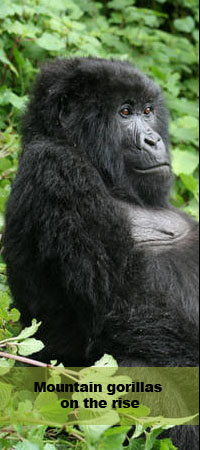|
1. FAILURE: NO GREEN ECONOMY IN SOUTH KOREA
The real two main features of the “green” policy are river destruction and nuclear development.The four rivers project has a budget of 22 trillion won and 16 large dams are being constructed. Various artificial lakes are also built favoring standing water and the proliferation of non-native fishes. Many important riparian and wetlands areas have been destroyed and significant environmental impacts such as erosion are already been observed. The “green” energy development includes the building of 14 new nuclear plants by 2024. The “green” economy plan of the President Lee Myung Bak is nothing else than a fake one!
2. SUCCESS: NORTH AMERICA’S MONARCH BUTTERFLY BOUNCED BACK
The monarch butterfly (Danausplexippus) has bounced back after its worst year ever. Mexico's latest survey of the butterfly's Mexican heartland shows that the insects winter occupied 4 hectares of forest, over double the area occupied last year. During the summer breeding season, monarchs live from 2-5 weeks during which they mate and lay the eggs that become the next generation. Monarchs have up to four generations each summer, each one traveling a little further north than the last. The last generation of the year migrates south.
3. FAILURE: NO RHINOS LEFT IN VIETNAM
The Java rhinoceros subspecies (Rhinoceros sondaicusannamiticus) has been to be hunted into extinction in Vietnam. No more Rhinos can be found in the wild in Vietnam now. The Indian Javan rhinoceros (R. sondaicusinermis) disappeared more than a century ago. Now only the Indonesian Javan rhino (R. sondaicussondaicus) remains alive, and it might not last much longer either. Just 50 or fewer of these animals are thought to exist in Ujung Kulon National Park on the island of Java.
4. SUCCESS: THE GIANT NEPTUNE’S CUP SPONGE REDISCOVERED
More than 100 years after it was last found in the wild, the giant Neptune’s cup sponge (Clionapatera) has been rediscovered in southern Singapore. The sponges were quickly overharvested until they disappeared from Singapore in the 1870s. The last time living sponges were observed in 1908 by collectors in Indonesia. The species was then thought to be extinct.
5. FAILURE: THE HAINAN BLACK-CRESTED GIBBON ON THE BRINK OF EXTINCTION
The Hainan black-crested gibbon (Nomascus hainanus) is the world’s rarest primate endemic to Hainan Island, China. Sixty years ago this species could be found all across Hainan Island. Now they are limited to a 2,100-hectare habitat with about 20 individuals. While the gibbons are legally protected, lack of enforcement has allowed illegal loggers and pulp paper plantation growers to take over 25 percent of the island’s rainforests, including a portion of the apes’ protected habitat. ESI believes intensive monitoring of the remaining groups of gibbons should be conducted, the habitat should be full protected with human and technical resources, and gun confiscation should be enforced.
6. SUCCESS: POPULATION OF MOUNTAIN GORILLAS ON THE RISE
The population of mountain gorillas (Gorilla beringeiberingei) has increased from 250 to 480 animals over the past 30 years. With sustained current conservation efforts and sustainable tourism, mountain gorillas should continue to double their population size over the next two decades.They live in the volcanoes of the Virunga Massif at the border of the Democratic Republic of the Congo (DRC), Rwanda and Uganda, in the BwindiNational Park in southwest Uganda on the border with DRC.
7. FAILURE: ILLEGAL LOGGING OF ROSEWOOD AND EBONY SEVERE THREAT TO MADASGASCAR’S NORTHEASTERN RAINFOREST
Unfinished rosewood and ebony boards from Madagascar are openly sold in many countries including the United States and the United Kingdom. Acoustic guitars and expensive oriental-style rosewood furniture are still made from rare, illegally logged trees in Madagascar, a country that have already lost 90 percent of its original forest. Rosewood trees are known to be some of the oldest trees in the eastern Malagasy humid forests and can live more than 400 years old. Illegal logging of rosewood and ebony is now posing the most severe threat to Madagascar’s dwindling northeastern rainforests. Harvesting these extremely heavy hardwoods is a labor intensive activity requiring coordination between local residents who manually cut the trees, but receive little profit. At the same, many endemic and endangered species are threatened to vanish forever like the red ruffed lemur that is hunted by illegal loggers. This lemur is known to feed on ebony trees. No more ebony trees means no more lemurs!
8. SUCCESS: THE SEYCHELLES MAGPIE ROBIN ON THE RECOVERY
The Seychelles Magpie Robin (Copsychus sechellarum) was originally present on eight islands in the Seychelles. In 1965, only 12-15 birds remained on only one island: Frégate Island.Once widespread in the Seychelles, it lived in closed-canopy forest, and its only predators were the native Wright's skink and an endemic snake, which stole eggs and chicks from the birds' nests. Conservation efforts are showing encouraging results. Now the total population is estimated to about 190 birds indicating a population increase of more than 100% over six years!
9. FAILURE. MANY PROTECTED AREAS FAIL TO PROTECT!
Protected areas were established to conserve important ecosystems or/and endangered species, but some of them are failing to meet their basic objective of protection. The first systematic review of protected areas worldwide reveals that 27 countries have seen some of their protected areas failing to achieve conservation of nature and associated cultural heritages. With growing pressures from agriculture, human population growth, pollution, resource extraction, poverty, corruption, and land right issues, the number of failing protected areas will probably increase dramatically.
10. SUCCESS. PROTECTING SHARKS BRINGS LARGE REVENUES
A new study by the Australian Institute of Marine Science found that shark tourism brings in $18 million to Palau a year (8% of the country's gross domestic product), making each shark worth around $180,000 annually. Sharks are worth much more alive than dead. Sold for consumption the shark is worth around $108. In this case a shark is worth a stunning 17,000 times more alive than dead.
|









